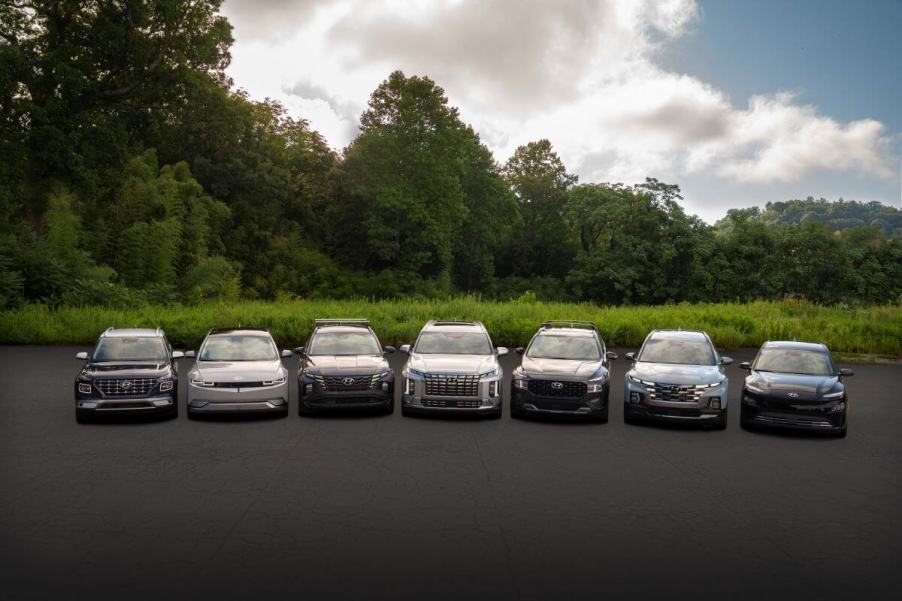
How Many SUV Segments Are There?
Just as the current automotive market is flooded with SUV models, there is a long list of segments into which each model falls. The number of segments, and what each entails, can be a bit confusing. For instance, some midsize SUVs can accommodate up to eight passengers, while others are maxed out at five occupants. So, how many SUV segments exist, how do they all differ, and what are some popular models in each category?
Subcompact SUVs
Subcompact models, as their designation hints, are the smallest SUVs available. These SUVs are the smallest in stature, ride lower to the ground, and most aren’t suitable for off-road ventures. Typically, subcompact SUVs are effectively high-riding hatchbacks best suited for commuters or those with small families.
The Automotive Science Group classifies subcompact SUVs as those with 117-124 cubic feet of interior volume. In the real world, this means they offer limited headroom, legroom, and cargo space. For instance, the subcompact Hyundai Kona has an overall length of 171.3 inches, while the midsize Hyundai Santa Fe is 188.4 inches overall. That equates to three inches less front legroom in the subcompact Kona and significantly less cargo space. Subcompact SUVs are typically powered by smaller engines than their counterparts, and with their smaller stature, they usually deliver the best fuel economy among all SUV classes.
Though they lack the size and power of larger SUVs, subcompacts serve as entry-level SUV models and are the most affordable options among their automaker’s SUV lineup.
Some popular subcompact SUV models include the Kia Soul, Honda HR-V, Nissan Kicks, Chevrolet Trailblazer, and Volkswagen Taos. Additionally, most new non-luxury subcompact SUVs start around the low- to mid-$20,000 range.
Compact SUVs
Compact SUVs serve as a step up in size, power, and practicality over subcompact models. Some popular examples include the Honda CR-V, Mazda CX-50, Hyundai Tucson, Toyota RAV4, BMW X3, Infiniti QX50, and Ford Bronco Sport.
Compact SUVs generally offer 125-140 cubic feet of interior volume and are slightly larger in just about every dimension over subcompact models. However, compact SUVs still have more car-like qualities behind the wheel versus larger SUV segments.
Compact SUVs require a notable price hike over subcompacts, but their added size, in addition to typically delivering more power and pragmatism, makes this segment perhaps the most popular among buyers. The RAV4, Tucson, Nissan Rogue, Chevrolet Equinox, CR-V, and Mazda CX-5 were all among the best-selling SUVs of 2022, according to Car and Driver.
Many mainstream compact SUVs start around in the high-$20,000 to low $30,000 price range. While almost all compact SUVs only offer seating for up to five, a few offer a third row of seats, including the Mitsubishi Outlander, Volkswagen Tiguan, and Mercedes-Benz GLB.
Midsize SUVs
Midsize SUVs are classified as offering between 141 and 170 cubic feet of interior volume. Generally, midsize models are several inches longer, taller, and sometimes wider than compact models, which furthers their cargo and passenger hauling abilities. Typically, these models offer better off-road and towing performance versus compact SUVs. Midsize SUVs also usually provide more upscale features than their smaller counterparts.
The midsize category is among the most popular SUV segments, but it’s also the most wide-ranging in the amount of models included. As such, there are essentially two subcategories of midsize SUVs based on how many passengers they can accommodate.
Two-row midsize SUVs
Two-row midsize SUVs provide a compromise between people and cargo-hauling abilities. These models can only accommodate five passengers, but they offer expansive cargo space behind the rear seats for those who don’t need the added seating capacity of a three-row model.
Some popular examples include the BMW X5, Honda Passport, Hyundai Santa Fe, and Genesis GV80. It’s important to note that some midsize SUVs come standard with two rows but can be outfitted with three rows as an optional extra.
Three-row midsize SUVs
Three-row midsize SUVs provide the best option for cargo and people hauling without the expansive dimensions of full-size SUVs. Three-row midsize SUVs can accommodate six to eight passengers with a foldable rear row of seats when more cargo space is needed. Generally, the third rows of these models are best suited for kids, given the limited head and legroom they offer. When in use, the third row significantly reduces rear cargo space, but as midsize models, they are typically easier to pilot than bulky full-size SUVs that offer better third-row accommodations and more cargo capacity behind the third row.
Some popular examples of three-row midsize SUVs include the Kia Telluride, Hyundai Palisade, Honda Pilot, Toyota Highlander, Mazda CX-9, Ford Explorer, Nissan Pathfinder, and Volkswagen Atlas. Luxury examples include the Acura MDX, Land Rover Discovery, and Audi Q7.
Full-size SUVs
Those who need the ultimate family and cargo haulers should consider shopping in the full-size SUV class. These models offer three-row seats without compromising on cargo space with over 170 cubic feet of interior volume. For example, the Chevrolet Suburban offers up to 41.5 cubic feet of cargo space, even with the third row of seats in use. Some full-size SUVs are also offered with extended wheelbases to further increase their interior pragmatism.
Models in this segment are more truck-like in their dimensions, powertrains, and driving dynamics. Their large engines, typically V6 or V8 units, also make them the most capable SUVs for towing. Of course, with their added dimensions come larger price tags, both at the dealership and at gas stations. Most non-luxury full-size SUVs start in the mid-$50,000 range, while some luxury models can crest the $100,000 mark.
Some well-known full-size SUVs include the Chevrolet Suburban, GMC Yukon, Ford Expedition, Toyota Sequoia, Mercedes-Benz GLS, Lincoln Navigator, BMW X7, and Cadillac Escalade.




